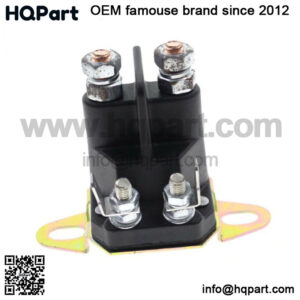A golf cart solenoid is one of the major components of any golf cart. This part is essential regardless whether you own an electric or gas golf cart because both types primarily rely on a solenoid for their movement.
What this means is whichever brand or model you choose for your cart, a solenoid is truly an indispensable part of the vehicle.
To get your golf cart going without a glitch, you most definitely need the solenoid of your cart to be functioning properly. Thus, it goes without saying that you must check this component occasionally to monitor its performance so that you don’t get stranded mid-way.
What is a golf cart solenoid?
What is a golf cart solenoid? A golf cart solenoid is a relay switch used in golf carts. This switch controls a high power circuit with the help of a low power circuit. The solenoid pushes a rod that closes a circuit with a magnetic coil. This creates an electric current which moves the cart.
The high power circuit is often an electrical motor power circuit in the case of an electric golf cart. In the case of a gas golf cart, the circuit is typically the ignition of the vehicle. A solenoid typically has two main parts – a steel plunger and a thin wire coil.
Since solenoids need to work very frequently; turning on and off each time you use the cart, they are prone to wear and tear easily. This is not surprising as they can switch on and off as much as 1,500 times a day).
One of the first indications that a solenoid is faulty is when your cart fails to start.
What does a Golf Cart Solenoid Do?
So what does a golf cart solenoid do exactly?
Solenoid in Electric Golf Carts:
- When you push down the pedal of the golf cart downwards, the inductive throttle sensor sends out the first low power signal to activate the solenoid on its low side and the speed controller. The low side is the steel rod of the solenoid.
- When the steel rod gets activated, a circuit is formed between the speed controlling systems and the traction motor of the cart.
- Once you release the pedal, the solenoid turns off automatically after a predefined time period to prevent your battery from getting drained.
Solenoid in Gas Golf Carts:
If you own a gas golf cart, the solenoid working principle is quite similar. However, when you press the pedal, a micro switch gets activated instead of the inductive throttle sensor.
The switch is responsible for sending out the low power signal to the solenoid.
The solenoid, in turn, forms the circuit between the starter or generator and the battery to get the cart up and running.
Where is the Solenoid Found on a Golf Cart?
Now that you know the solenoid is like the heart of a golf cart, it is quite essential that you know where it is located. Luckily, it is positioned at the same place irrespective of the type of cart you own.
Where is the solenoid located on a golf cart? In most cases a golf cart solenoid is positioned below the seat. It features four terminals with a wired connection for each terminal. Two of these terminals are large in size whereas the other two will be smaller.
Symptoms of a Bad Solenoid
There are some signs that could indicate you have a bad or faulty solenoid in your electric or gas golf cart. Watching out for these signs can help you to take the necessary steps before too much damage is done.
In an electric cart, one of the key signs of a faulty solenoid is when you turn your cart’s ignition on, and find no electricity is being transferred to the controller from the solenoid.
When this occurs the usual solenoid click on and off associated with the ignition switch will not take place. This is because the solenoid fails to derive the required electricity for functioning because of a worn-out coil, loose connections or a weak battery.
Another reason for a bad solenoid is that the contacts are beginning to get damaged because of high current passing through them or overheating.
This issue must be addressed at once because if neglected the starter can also be affected. This means that both the starter and the solenoid will have to be replaced.
In a gas cart, a bad solenoid prevents the starter from being engaged and therefore results in the engine not turning over. You will hear a series of futile clicking sounds indicating that the solenoid is faulty.
Yes it’s possible to bypassing the solenoid on a golf cart. However bypassing the solenoid is not recommended as further damage is likely to occur.
Bypassing a solenoid should only be considered if you do not have a multimeter nearby.
How to Bypass the Solenoid on a Golf Cart
If you must bypass the solenoid on your golf cart, you need be very careful how you go about it. I have outlined some simple steps below to help you.
- Connect the two high side large wires to the large terminals of the solenoid.
- Try to start the golf cart after establishing this connection. If the cart does not start, then it is a clear sign that your solenoid does not have a problem.
However, if it does, this does not indicate that the solenoid is the cause of the problem. You will have to check out the complete ignition system.
- In the case of an electric golf cart, I advise that you stop your checking at the key switch and take the assistance of a mechanic to sort out things for you.
- But, if you own a gas golf cart, you can consider taking a look at the micro switch as well.
How to Test a Golf Cart Solenoid
To check if it’s time to replace your solenoid please follow the steps outlined below:
IMPORTANT: Don’t forget to wear a pair of safety glasses and gloves before you begin the testing process. These precautionary measures are for your own safety and are highly recommended.
- The very first thing you must do is to disable the mobility of your golf cart. This is to prevent it from accidentally moving and resulting in damage to property or injury. For this, you will have to disconnect the large high side wires from the big terminals.
Depending on the securing method used by the solenoid, you may need two wrenches for the disconnection. This disconnects the solenoid from the high voltage side.
- After disconnecting the solenoid, use electric tape and seal each cable end separately. This prevents the ends from touching each other and accidentally forming a circuit or accidental connection through a metal conductor. This will also ensure that your vehicle does not start moving in the middle of your testing process.
- Turn on the engine of the cart and press the pedal downwards. If you hear a clicking sound, then it means that the low side voltage is working. But, if there is no such sound, it means that either there is no low side voltage or there is a problem with the solenoid.
- Use a voltmeter and engage the solenoid. You should hear a click sound when the engaging is done properly.
- Check for continuity between the two high side terminals on the solenoid using a multimeter. Before using the multimeter, make sure that you know the operating resistance range of the solenoid.
- Set the multimeter reading to ohms and place a lead on each of the two terminals. If the reading indicates open lead or infinity, replace the solenoid because it has an internal fault.
If the reading is outside this range, but the solenoid is working, I still recommend opting for a replacement as other components can also experience damage. If the resistance is within the permissible range, there is no problem with the solenoid.
- Check the power getting delivered to the solenoid. Set the multimeter reading to volts and activate the solenoid circuit by connecting the multimeter leads to the small terminals of the solenoid. If the reading is not the specified battery pack voltage, there is no problem with the solenoid.

